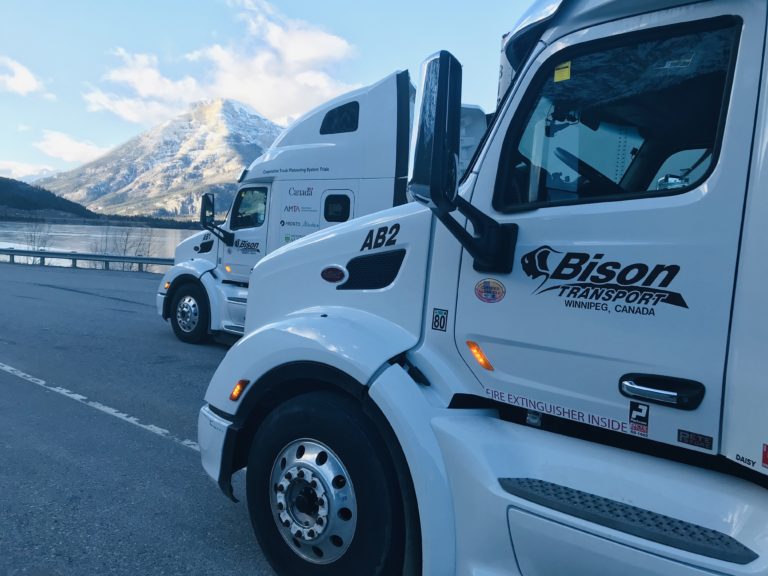Truck platooning trials conclude in Alberta
Daisy and Lily are a couple no more.
The two nicknamed Peterbilt 579s had been connected by electronic handshakes to establish tight following distances for on-road truck platooning trials conducted by the Alberta Motor Transport Association (AMTA).
Such following distances are established to improve aerodynamic drag in the name of better fuel economy. While the driver of a platoon’s lead truck is responsible for acceleration and braking, the vehicle behind it relies on semi-autonomous controls.

These particular tractor-trailers completed 21 trips between Edmonton and Calgary during trial runs that began last September, traveling a collective 23,115 km under the watch of nine Bison Transport drivers and 10 researchers. Now the work begins to analyze the data from 13 distinct sources to measure the results.
“Not only is platooning safe and efficient, but it is also a greener way to ensure goods get to where they need to go,” AMTA president Chris Nash said in a press release. “This data will be key for the industry moving forward.”
Alberta’s on-road Cooperative Truck Platooning System trials add to previous track tests conducted at Transport Canada’s Motor Vehicle Test Centre in Blainville, Que., which helped to see how platooning trucks would respond in situations like sudden brake applications by a driver in the lead truck. Other research by Auburn University and FP Innovations has seen platoons take to Quebec highways and logging roads.
“Truck platooning will help the trucking industry advance new technologies that can improve safety and efficiency, while also reducing congestion and greenhouse gases,” said Transport Minister Omar Alghabra.
Earlier Transport Canada research determined that 6% fuel economy gains were possible in platoons of three tractor-trailers each weighing 65,000 lb. and spaced 57 feet apart.
Meanwhile, the North American Council for Freight Efficiency (NACFE) has concluded platooning trucks can see 4% increases in fuel economy across two trucks that maintain following distances of 40 to 50 feet. Trucks in the rear position can see fuel economy improve by as much as 10%.
But questions have been raised about the extent of such fuel savings in real-world settings, when the platoons need to uncouple and recouple to account for other traffic. Daimler Trucks abandoned its research into platooning after determining the process was not viable, choosing instead to focus its efforts on developing highly autonomous vehicles.
Transport Canada provided $2.3 million in funding for the AMTA project, adding to support from Alberta Transportation and research partnerships with Bison Transport, Pronto, the University of Alberta, Solaris Fatigue Management, Tantus, PMG Technologies and Esso Commercial Cardlock.
Have your say
This is a moderated forum. Comments will no longer be published unless they are accompanied by a first and last name and a verifiable email address. (Today's Trucking will not publish or share the email address.) Profane language and content deemed to be libelous, racist, or threatening in nature will not be published under any circumstances.
-
Yes why not ROAD TRAINS? One tractor: two, three or even more trailers? Some places pull 3 and 4 or more trailers (48ft and 53ft). Then drop them in special lots for local drivers to pick up.
This is way more “fuel efficient” and human resources efficient if there is really a “Driver Shortage”.
Seriously. I had to read the beginning of one of your paragraphs and it caused me to wonder. ” Between Alberta and Calgary”?
I know now why I question those ” in charge more than ever before”.
-
Thanks for bringing that to our attention. The reference should have been “between Edmonton and Calgary”, and the change has been made accordingly.
Tesla Semi will make it better.
The bottom line is: It made no sense, as any route that you can platoon on , you could be pulling a turnpike double and use one skilled driver, with one tractor. A much greater savings of Human Resources, equipment and fuel! I suspect some tax dollars where also wasted.